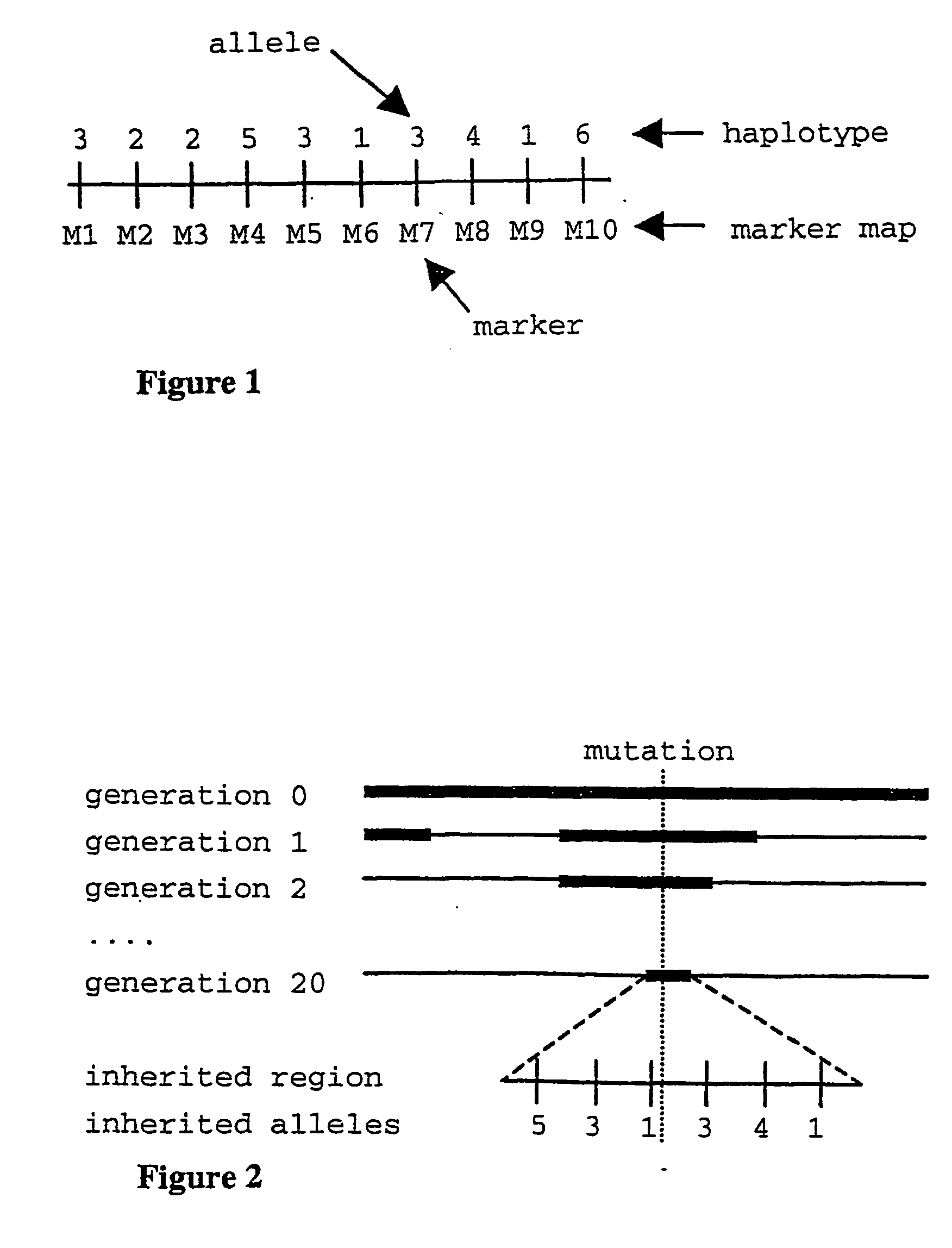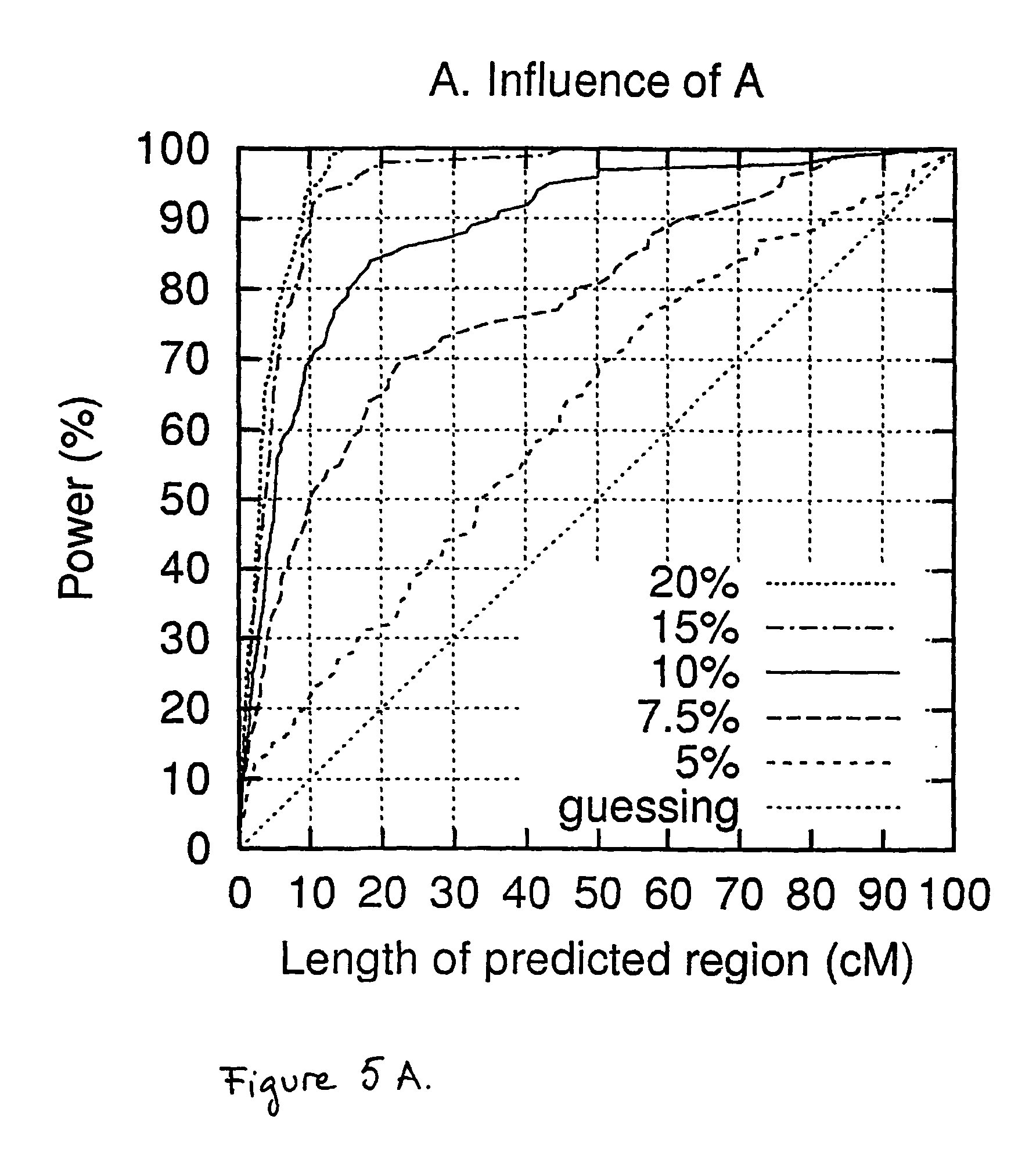Method for gene mapping from chromosome and phenotype data
a technology of applied in the field of gene mapping from chromosome and phenotype data, can solve the problems of reducing the computational complexity of the task, reducing the area to be analyzed with expensive laboratory methods, and reducing the area to be analyzed
- Summary
- Abstract
- Description
- Claims
- Application Information
AI Technical Summary
Problems solved by technology
Method used
Image
Examples
example 1
Simulation of Data
We designed several different test settings, with variation in the fraction (A) of mutation carriers in the disease-associated chromosomes, in the number of founders who introduced the mutation to the population, and in the amount of missing information. For statistical analyses, we created 100 independent artificial data sets in each test setting. Great care was taken to generate realistic data by a simulation procedure that included four steps: pedigree generation, simulation of inheritance, diagnosing, and sampling.
The population pedigree was set to grow from 100 to 100,000 individuals in a period of 20 generations. In each generation, the selection of parents for each child was random, but once a couple was formed, all subsequent children allocated to either of the parents were set to be common children of the couple.
The inheritance of chromosomes within the population pedigree was simulated by first allocating a continuous chromosomal segment of 100 cent...
example 2
Analysis of TreeDT
First we assess the prediction accuracy of TreeDT with different values of A, the proportion of disease-associated chromosomes that actually carry the mutation (FIG. 5A). The results are reported as curves that show the percentage of 100 data sets where the gene is within the predicted region, as a function of the length of the predicted region. Or, in other words, the x coordinate tells the cost a geneticist is willing to pay, in terms of the length of the region to be further analyzed, and the y coordinate gives the probability that the gene is within the region. For A=20% or 15% the accuracy is very good, and with lower values of A the accuracy decreases until with A=5% only in 20-30% of data sets can the gene be localized within a reasonable accuracy of 10-20 cM. We remind the reader that the test settings have been designed to be challenging, and to test the limits of the approach.
Next we evaluate the effect of the only parameter of TreeDT, the number of d...
example 3
Comparison to Other Methods
TreeDT, HPM, and m-TDT have practically identical performance in localizing the DS gene in the baseline setting (FIG. 6A). TDT is clearly inferior compared to the other methods. Tests with other values of A give similar results.
In a test setting with three founders who introduced the mutation to the population, differences between the three best methods start to appear (FIG. 6B). TreeDT has an edge over HPM, which in turn has an edge over m-TDT. TDT barely beats random guessing.
Finally, we compare the methods with a large amount of missing data (FIG. 6C). Expectedly, HPM is most robust with respect to missing data since it allows gaps in its haplotype patterns. Surprisingly, TreeDT is not much weaker than HPM, although no actions have been taken in it to account for missing or erroneus data. Performance of m-TDT degrades much more clearly.
Method to method comparisons (not shown) indicate that the prediction errors are mostly caused by random effect...
PUM
| Property | Measurement | Unit |
|---|---|---|
| Magnetic field | aaaaa | aaaaa |
| Linkage disequilibrium | aaaaa | aaaaa |
Abstract
Description
Claims
Application Information
 Login to View More
Login to View More - R&D
- Intellectual Property
- Life Sciences
- Materials
- Tech Scout
- Unparalleled Data Quality
- Higher Quality Content
- 60% Fewer Hallucinations
Browse by: Latest US Patents, China's latest patents, Technical Efficacy Thesaurus, Application Domain, Technology Topic, Popular Technical Reports.
© 2025 PatSnap. All rights reserved.Legal|Privacy policy|Modern Slavery Act Transparency Statement|Sitemap|About US| Contact US: help@patsnap.com



